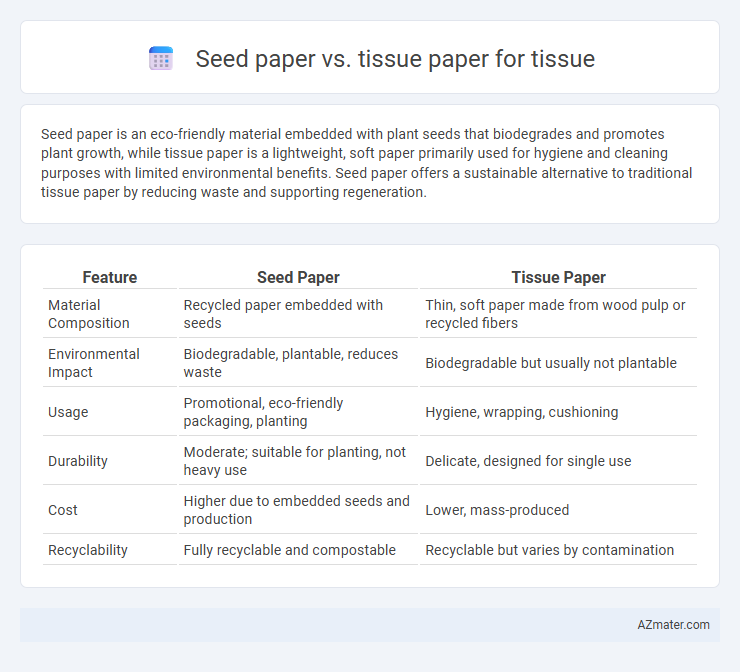Seed paper is an eco-friendly material embedded with plant seeds that biodegrades and promotes plant growth, while tissue paper is a lightweight, soft paper primarily used for hygiene and cleaning purposes with limited environmental benefits. Seed paper offers a sustainable alternative to traditional tissue paper by reducing waste and supporting regeneration.
Table of Comparison
| Feature | Seed Paper | Tissue Paper |
|---|---|---|
| Material Composition | Recycled paper embedded with seeds | Thin, soft paper made from wood pulp or recycled fibers |
| Environmental Impact | Biodegradable, plantable, reduces waste | Biodegradable but usually not plantable |
| Usage | Promotional, eco-friendly packaging, planting | Hygiene, wrapping, cushioning |
| Durability | Moderate; suitable for planting, not heavy use | Delicate, designed for single use |
| Cost | Higher due to embedded seeds and production | Lower, mass-produced |
| Recyclability | Fully recyclable and compostable | Recyclable but varies by contamination |
Introduction to Seed Paper and Tissue Paper
Seed paper is an eco-friendly, biodegradable material embedded with seeds that can be planted to grow flowers or herbs, promoting sustainability and reducing waste. Tissue paper, commonly made from recycled fibers or virgin pulp, is soft, lightweight, and primarily used for hygiene and packaging purposes. Both materials serve distinct functions, with seed paper focusing on environmental regeneration and tissue paper emphasizing everyday convenience and hygiene.
What is Seed Paper?
Seed paper is a biodegradable material embedded with seeds that can be planted to grow flowers, herbs, or vegetables, offering an eco-friendly alternative to conventional tissue paper. Unlike traditional tissue paper, which is primarily used for cleaning or wrapping, seed paper serves a dual purpose by providing utility while promoting sustainability through plant growth. This innovative paper decomposes naturally, enriching the soil and reducing waste in landfills.
What is Tissue Paper?
Tissue paper is a lightweight, thin paper made from cellulose fibers, commonly used for hygiene, packaging, and decorative purposes. It offers softness, absorbency, and flexibility, making it ideal for facial tissues, toilet paper, and gift wrapping. Unlike seed paper, which contains embedded seeds for planting, tissue paper is primarily designed for single-use applications and biodegradability.
Environmental Impact: Seed Paper vs. Tissue Paper
Seed paper is biodegradable and promotes plant growth, significantly reducing waste and enhancing soil quality, making it a sustainable alternative to traditional tissue paper. Tissue paper, often made from virgin pulp or recycled fibers, typically requires extensive water and energy consumption during production, contributing to deforestation and higher carbon emissions. Choosing seed paper over conventional tissue paper supports environmental conservation by minimizing landfill waste and encouraging ecological restoration.
Biodegradability and Sustainability
Seed paper is highly biodegradable and eco-friendly, embedded with plant seeds that decompose naturally, promoting sustainability by enabling plant growth after use. Tissue paper, while biodegradable, is often made from virgin or recycled fibers and may include chemical treatments that slow decomposition and impact environmental sustainability. Seed paper offers superior environmental benefits by combining waste reduction with active ecological restoration, making it a more sustainable choice compared to traditional tissue paper.
Manufacturing Processes Compared
Seed paper production integrates plant seeds into recycled paper pulp, requiring specialized embedding techniques and slower drying times to preserve seed viability, while tissue paper manufacturing involves high-speed creping and calendaring processes designed for softness and absorbency, utilizing wood pulp or recycled fibers without seed inclusion. Seed paper uses eco-friendly, biodegradable fibers combined with organic seeds, processed at lower temperatures to maintain germination potential, whereas tissue paper is produced through high-temperature pressing and chemical treatments to enhance texture and durability but lacks seed components. The distinct manufacturing methods reflect divergent end uses: seed paper emphasizes sustainable regeneration and planting after use, while tissue paper prioritizes hygiene, softness, and disposability.
Common Uses and Applications
Seed paper is primarily used for eco-friendly marketing, wedding invitations, and promotional materials that can be planted to grow flowers or herbs, emphasizing sustainability. Tissue paper is commonly utilized in packaging, gift wrapping, and personal hygiene products due to its softness, lightweight nature, and absorbency. While seed paper integrates environmental benefits through its biodegradable and plantable qualities, tissue paper focuses on practicality and consumer convenience across various industries.
Cost Analysis: Seed Paper vs. Tissue Paper
Seed paper generally incurs higher production costs due to embedded seeds and specialized manufacturing processes, making it more expensive than conventional tissue paper. Tissue paper costs remain lower because of mass production efficiency and simpler raw materials like wood pulp or recycled fibers. When evaluating cost-effectiveness, businesses must consider seed paper's environmental benefits against its premium price, while tissue paper offers affordability but lacks eco-friendly properties.
Consumer Preferences and Trends
Consumers increasingly favor seed paper for tissue products due to its eco-friendly and sustainable attributes, aligning with rising environmental consciousness. Market trends indicate a growing demand for biodegradable and plantable tissues, which seed paper effectively satisfies compared to conventional tissue paper. Awareness of seed paper's dual functionality--serving as tissue and as a seed source--drives consumer preference and frames future tissue product innovations.
Future Outlook for Eco-Friendly Paper Products
Seed paper and tissue paper represent promising directions in eco-friendly paper products, with seed paper offering a biodegradable option embedded with organic seeds that promote sustainability through plant growth. The tissue paper market is increasingly adopting recycled fibers and sustainable sourcing to reduce deforestation and carbon footprint. Advances in biodegradable additives and manufacturing technologies are driving a future where both seed paper and eco-friendly tissue paper significantly contribute to reducing environmental impact in the paper industry.

Infographic: Seed paper vs Tissue paper for Tissue
 azmater.com
azmater.com